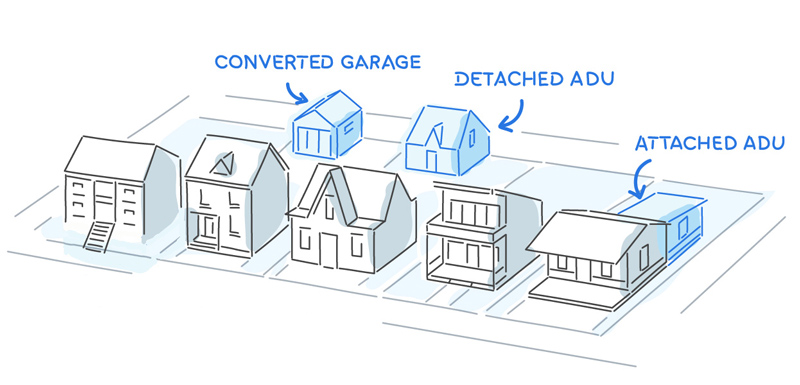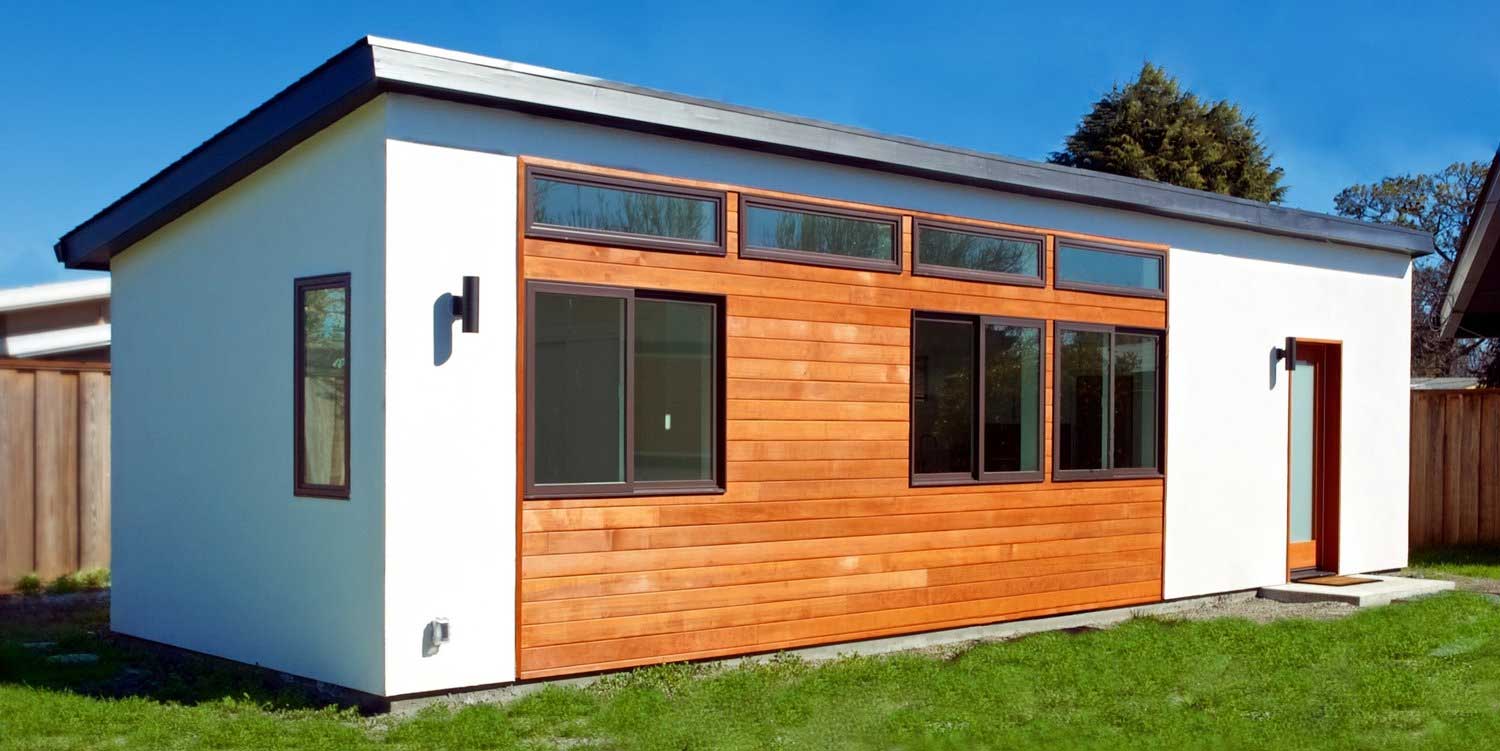An Accessory Dwelling Unit (aka second unit, backyard cottage, or granny unit) is an independent living facility for one or more persons, located on the same lot as a single-family or multi-family home. ADUs can be attached to the primary residence, detached from the primary residence, or within the walls of an existing home. An ADU must have a full, separate kitchen (including stove, refrigerator, and sink), separate bathroom, and separate entrance. No matter where they are located, ADUs are an affordable, innovative and useful option to add much-needed housing in California.
These are the requirements for an ADU:
- Separate water water connection and water meter.
- Full utility hookup (gas/electric).
- Fully functional living space (kitchen, bedroom, and bathroom).
- A foundation.

Types of ADUs
There are many different types of ADUs, but they generally fall into one of these categories:
- Detached: The unit is separated from the primary structure. This might be a stand-alone construction or a garage apartment.
- Attached: The unit is attached to the primary structure.
- Converted Existing Space: Space (e.g., master bedroom, attached garage, storage area, or similar use, or an accessory structure) on the lot of the primary residence that is converted into an independent living unit.
- Junior Accessory Dwelling Unit (JADU): A specific type of conversion of existing space that is contained entirely within an existing or proposed single-family residence
What is a Junior ADU?
A Junior Accessory Dwelling Unit (JADU) is a smaller, attached version of an ADU. These are the requirements for a JADU:
- Less than 500 square feet.
- Constructed within the existing single-family home.
- Must include a kitchen.
- Can share a bathroom with the residence.
- Need their own entrance.
JADUs share sanitation and utilities with the primary residence, making them less expensive and easier to build. Junior ADUs can be built in addition to a conventional ADU. However, owners must occupy JADUs ruling out use as a rental property.
Why Build an ADU?
There are many benefits of ADUs. Not only can they provide a new flexible living space, but they can also be a financial asset, with the average ADU rent being $2,200 a month in the SF Bay Area.
With California’s housing being scarce, ADUs add much needed housing to the market. The state of California has created incentives for homeowners to build ADUs. For properties in Marin County jurisdiction (see the note below on unincorporated areas of Marin) rather than an incorporated town, the permit fees for ADUs may be waived if the units meet these conditions:
- Up to $10,000 for ADUs that are rented at rates at or below 80% the Area Median Income.
- Up to $5,000 for ADUs that are rented at rates between 81-120% of the Area Median income.
- Up to $2,500 for ADUs that are rented at market-rate.
Local Regulations for ADUs
Each Marin County town has slightly different rules regarding the development and use of ADUs. To learn more about ADU’s in your town, go to ADUMarin.com. This is a partnership between 10 local towns and the County of Marin:
- Belvedere
- Corte Madera
- Fairfax
- Larkspur
- Mill Valley
- Novato
- Ross
- San Anselmo
- Sausalito
- Marin County (including Greenbrae, Kentfield, and West Marin). See the following Important Note.
Two towns are not yet included in ADUMarin because they are preparing their ordinances for ADUs:
San Rafael– The city of San Rafael’s ADU ordinance is here. The ordinance attempts to make building an ADU easier in San Rafael.
Tiburon– The town of Tiburon also has a draft ordinance.
IMPORTANT NOTE
Most of Marin County (~ 55%) is unincorporated, meaning that planning, building permits, and other services are administered by the county from its offices at the Marin Civic Center in San Rafael. Many unincorporated areas are within incorporated towns; for example, Novato, San Rafael, Kentfield, Greenbrae, Larkspur, Tiburon, and Mill Valley. See this map of unincorporated areas.
California Regulations on ADUs
The California Department of Housing and Community Development provides a well-written Accessory Dwelling Handbook that explains laws, zoning, requirements, and more with answers to many questions.
ADU Facts
New state laws have made it easier than ever for homeowners to build an ADU. Because of this, California has seen a massive boom of new ADU projects. Here are interesting statistics regarding ADUs:
- ADU rent in California is highest in the SF Bay Area, with the median rent being $2,200 a month.
- The median statewide construction cost is $150,000, or $250 / square foot.
- Over 12,392 ADUs were approved in 2020, the most ADU permits ever issued in California.
- 60% of ADUs are built as one-bedroom units, with studio units being the second most popular type (18%).
- A large portion of new ADUs (37%) cost less than $100,000 to build.
- Marin County has made ADU grants eligible for property owners who rely on septic systems.
- Marin County gave out 36 fee waivers in 2020 for the creation of ADUs.
Getting Started
Identify goals. First, you need to figure out what type of ADU best suits your property and goals. Look at photos and floor plans of ADUs and find something that fits your needs. You can do this at ADUMarin.
Study the rules. Remember, each town in Marin County has different rules regarding ADUs. Make sure you’re up to date on what you can and cannot build. See Rules for ADUs, above. Before developing plans, consult with your planning department to determine whether your property is suitable for an ADU.
Check the Internet. There are many sources for ADU plans and prefab ADUs. Just search for these terms.

Example of prefab ADU at modernempathy.com
Assemble your team. Find and select an experienced team that may have previous work at a similar scale, it can also be helpful if they have already worked in your area. Research designers or architects in your area, and find a team you feel confident in. These professionals can also help you contact your city to get more information.


